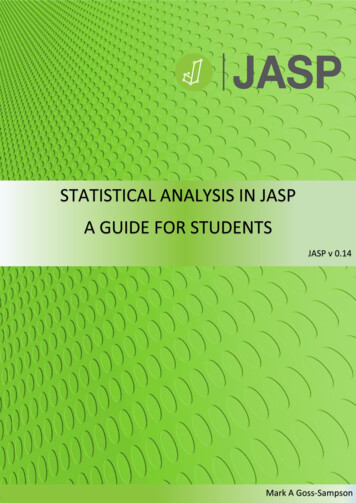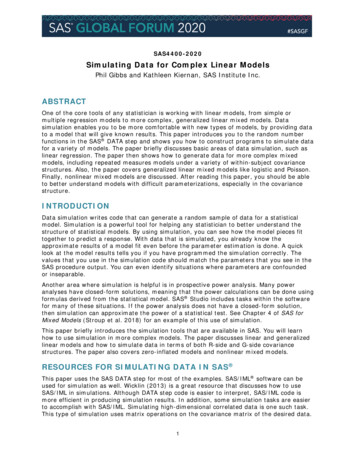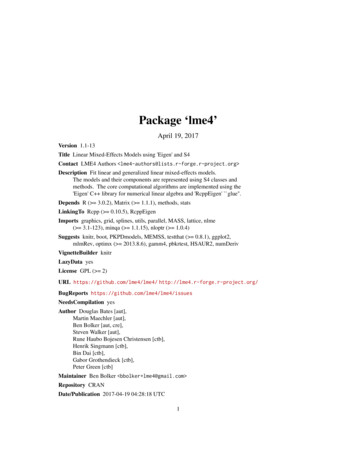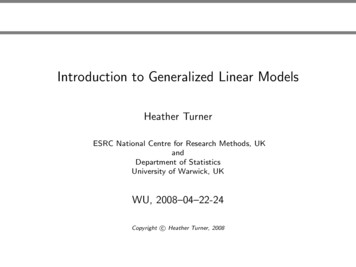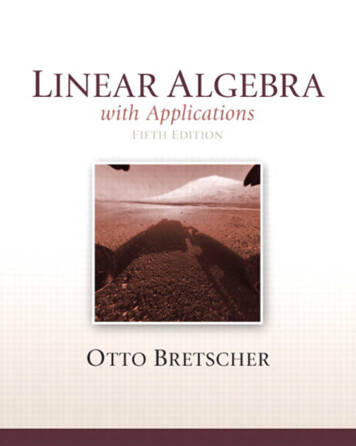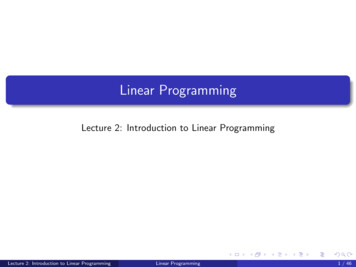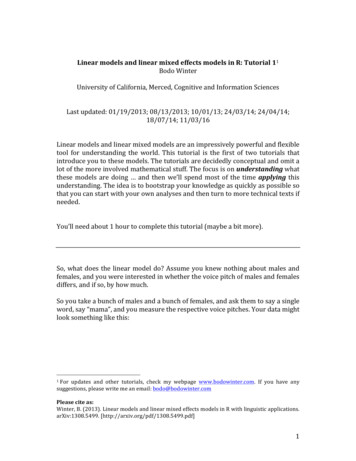
Transcription
Linear models and linear mixed effects models in R: Tutorial 11Bodo WinterUniversity of California, Merced, Cognitive and Information SciencesLast updated: 01/19/2013; 08/13/2013; 10/01/13; 24/03/14; 24/04/14;18/07/14; 11/03/16Linear models and linear mixed models are an impressively powerful and flexibletool for understanding the world. This tutorial is the first of two tutorials thatintroduce you to these models. The tutorials are decidedly conceptual and omit alot of the more involved mathematical stuff. The focus is on understanding whatthese models are doing and then we’ll spend most of the time applying thisunderstanding. The idea is to bootstrap your knowledge as quickly as possible sothat you can start with your own analyses and then turn to more technical texts ifneeded.You’ll need about 1 hour to complete this tutorial (maybe a bit more).So, what does the linear model do? Assume you knew nothing about males andfemales, and you were interested in whether the voice pitch of males and femalesdiffers, and if so, by how much.So you take a bunch of males and a bunch of females, and ask them to say a singleword, say “mama”, and you measure the respective voice pitches. Your data mightlook something like this:1 For updates and other tutorials, check my webpage www.bodowinter.com. If you have anysuggestions, please write me an email: bodo@bodowinter.comPlease cite as:Winter, B. (2013). Linear models and linear mixed effects models in R with linguistic applications.arXiv:1308.5499. [http://arxiv.org/pdf/1308.5499.pdf]1
e.Pitch233 Hz204 Hz242 Hz130 Hz112 Hz142 Hz“Hz” (Hertz) is a measure of pitch where higher values mean higher pitch.You might look at this table and say that it’s quite obvious that females havehigher voice pitch than males. After all, the female values seem to be about 100Hz above the male ones.But, in fact, it could be the case that females and males have the same pitch, andyou were just unlucky and happened to choose some exceptionally high-pitchedfemales and some exceptionally low-pitched males. Intuitively, the pattern in thetable seems pretty straightforward, but we might want a more precise estimateof the difference between males and females, and we might also want an estimateabout how likely (or unlikely) that difference in voice pitch could have arisen justbecause of drawing an unlucky sample.This is where the linear model comes in. In this case, its task is to give you somevalues about voice pitch for males and females as well as some probabilityvalue as to how likely those values are.The basic idea is to express your relationship of interest (in this case, the onebetween sex and voice pitch) as a simple formula such as this one:pitch sexThis reads “pitch predicted by sex” or “pitch as a function of sex”. Some peoplecall the thing on the left the “dependent variable” (the thing you measure) andthe thing on the right the “independent variable”. Others call the thing on theright the “explanatory variable” (this sounds too causal to me) or the “predictor”.I’ll call it “fixed effect”, and this terminology will make sense later on in tutorial 2.Now, the world isn’t perfect. Things aren’t quite as deterministic as the aboveformula suggests. Pitch is not completely determined by sex, but also by a bunchof different factors such as language, dialect, personality, age and what not. Evenif we measured all of these factors, there would still be other factors influencingpitch that we cannot control for. Perhaps, a subject in your data had a hangoveron the morning of the recording (causing the voice to be lower than usual), or thesubject was just more nervous on that particular day (causing the voice to behigher). We can never measure and control all of these things. The world is full of2
stuff that is outside the purview of our little experiment. Hence, let’s update ourformula to capture the existence of these “random” factors.pitch sex εThis “ε” (read “epsilon”) is an error term. It stands for all of the things that affectpitch that are not sex, all of the stuff that – from the perspective of ourexperiment – is random or uncontrollable.The formula above is a schematic depiction of the linear model that we’re goingto build. Note that the part of the formula on the right-hand side conceptuallydivides the world into stuff that you can understand (the “fixed effect” sex) andstuff that you can’t understand (the random part “ε”). You could call the formerthe “structural” or “systematic” part of your model and the latter the “random” or“probabilistic” part of the model.Hands-on exercise: Let’s start!O.k., let’s move to R, the statistical programming environment that we’ll use forthe rest of this tutorial2. Let’s create the dataset that we’ll use for our analysis.Type in:pitch c(233,204,242,130,112,142)sex c(rep("female",3),rep("male",3))The first line concatenates our 6 data points from above and saves it in an objectthat we named pitch. The second line repeats the word “female” 3 times andthen the word “male” 3 times and concatenates these 6 words into an objectthat we named sex.For a better overview, let’s combine these two objects into a data frame:my.df data.frame(sex,pitch)Now we have a data frame object that we named my.df, and if you type that,you’ll see this:You don’t have R? Don’t worry, it’s free and works on all platforms. You can get it here:http://www.r-project.org/ You might want to read a quick intro to R before you proceed – buteven if you don’t, you’ll be able to follow everything. Just type in everything you see in dark blue.23
O.k., now we’ll proceed with the linear model. We take our formula above andfeed it into the lm() function except that we omit the “ε” term, because thelinear model function doesn’t need you to specify this.xmdl lm(pitch sex, my.df)We modeled pitch as a function of sex, taken from the data frame my.df andwe saved this model into an object that we named xmdl. To see what the linearmodel did, we have to “summarize” this object using the function summary():summary(xmdl)If you do this, you should see this:Lots of stuff here. First, you’re being reminded of the model formula that youentered. Then, the model gives you the residuals (what this is will be discussedlater), and the coefficients of the fixed effects (again, explanations follow bearwith me for a moment). Then, the output prints some overall results of the modelthat you constructed.4
We have to work through this output. Let’s start with “Multiple R-Squared”. Thisrefers to the statistic R2 which is a measure of “variance explained” or if youprefer less causal language, it is a measure of “variance accounted for”. R2 valuesrange from 0 to 1. Our R2 is 0.921, which is quite high you can interpret this asshowing that 92.1% of the stuff that’s happening in our dataset is “explained” byour model. In this case, because we have only one thing in our model doing theexplaining (the fixed effect “sex”), the R2 reflects how much variance in our data isaccounted for by differences between males and females.In general, you want R2 values to be high, but what is considered a high R2 valuedepends on your field and on your phenomenon of study. If the system you studyis very deterministic, R2 values can approach 1. But in most of biology and thesocial sciences, where we study complex or messy systems that are affected by awhole bunch of different phenomena, we frequently deal with much lower R2values.The “Adjusted R-squared” value is a slightly different R2 value that not only looksat how much variance is “explained”, but also at how many fixed effects you usedto do the explaining. So, in the case of our model above, the two values are quitesimilar to each other, but in some cases the adjusted R2adj can be much lower ifyou have a lot of fixed effects (say, you also used age, psychological traits, dialectetc. to predict pitch).So much for R2. Next line down you see the thing that everybody is crazy for: Yourstatistical test of “significance”. If you’ve already done research, your eyes willprobably immediately jump to the p-value, which in many fields is your ticket forpublishing your work. There’s a little bit of an obsession with p-values andeven though they are regarded as so important, they are quite oftenmisunderstood! So what exactly does the p-value mean here?One way to phrase it is to say that assuming your model is doing nothing, theprobability of your data is relatively low (because the p-value is small in this case).Technically speaking, the p-value is a conditional probability, it is a probabilityunder the condition that the null hypothesis is true. In this case, the null hypothesisis “sex has no effect on pitch”. And, the linear model shows that if this hypothesisis true, then the data would be quite unlikely. This is then interpreted as showingthat the alternative hypothesis “sex affects pitch” is more likely and hence thatyour result is “statistically significant”.Usually, however, you have to distinguish between the significance of the overallmodel (the p-value at the very bottom of the output), which considers all effectstogether, from the p-value of individual coefficients (which you find in thecoefficients table above the overall significance). We’ll talk more about this in abit.5
Then comes the F-value and the degrees of freedom. For an explanation of this,see my tutorial on ANOVAs and the logic behind the F-test(http://bodowinter.com/tutorial/bw anova general.pdf). For a general linearmodel analysis, you probably need this value to report your results. If you wantedto say that your result is “significant”, you would have to write something likethis:“We constructed a linear model of pitch as a function of sex. This modelwas significant (F(1,4) 46.61, p 0.01). ( )”Now, let’s look at the coefficient table. Here it is again:Note that the p-value for the overall model was p 0.002407, which is the same asthe p-value on the right-hand side of the coefficients table in the row that startswith “sexmale”. This is because your model had only one fixed effect (namely,“sex”) and so the significance of the overall model is the same as the significancefor this coefficient. If you had multiple fixed effects, then the significance of theoverall model and the significance of this coefficient would be different. That isbecause the significance of the overall model takes all fixed effects (allexplanatory variables) into account whereas the coefficients table looks at eachfixed effect individually.But why does it say “sexmale” rather than just “sex”, which is how we named ourfixed effect? And where did the females go? If you look at the estimate in the rowthat starts with “(Intercept)”, you’ll see that the value is 226.33 Hz. This looks likeit could be the estimated mean of the female voice pitches. If you type thefollowing mean(my.df[my.df sex "female",] pitch) you’ll get the mean of female voice pitch values, and you’ll see that this value isvery similar to the estimate value in the “(Intercept)” column.Next, note that the estimate for “sexmale” is negative. If you subtract the estimatein the first row from the second, you’ll get 128, which is the mean of the malevoice pitches (you can verify that by repeating the above command andexchanging “male” for “female”).To sum up, the estimate for “(Intercept)” is the estimate for the female category,and the estimate for “sexmale” is the estimate for the difference between the6
females and the male category. This may seem like a very roundabout way ofshowing a difference between two categories, so let’s unpack this further.200150100050Voice pitch (Hz)250300Internally, linear models like to think in lines. So here’s a picture of the way thelinear model sees your data:femalemale200150100050Voice pitch (Hz)250300The linear model imagines the difference between males and females as a slope.So, to go “from females to males”, you have to go down –98.33 which is exactlythe coefficient that we’ve seen above. The internal coordinate system looks likethis:femalemaleFemales are sitting at the x-coordinate zero at the y-intercept (the point wherethe line crosses the y-axis), and males are sitting at the x-coordinate 1. So now,the output makes a hella more sense to us:7
The females are hidden behind this mysterious “(Intercept)” and the estimate forthat intercept is the estimate for female voice pitch! Then, the difference betweenfemales and males is expressed as a slope “going down” by 98.33. The p-valuesto the right of this table correspond to tests whether each coefficient is “nonzero”. Obviously, 226.33 Hz is different from zero, so the intercept is “significant”with a very low p-value. The slope -98.33 is also different from zero (but in thenegative direction), and so this is significant as well.You might ask yourself: Why did the model choose females to be the interceptrather than males? And what is the basis for choosing one reference level overthe other? The lm() function simply takes whatever comes first in the alphabet!“f” comes before “m”, making “females” the intercept at x 0 and “males” the slopeof going from 0 to 1.It might not appear straightforward to you why we can express categoricaldifferences (here, between men and women) as a slope. The reason why thisworks is because the difference between two categories is exactly correlated withthe slope between two categories. The following figures will help you realize thisfact. In those pictures, I increased the distance between two categories andexactly proportional to this increase in distance, the slope increased as well.25201510005c(my.ys, my.ys 8)201510Slope: 8c(rep(0, 4), rep(1, 4))2015100c(my.ys, my.ys 14)Slope: 145201510c(my.ys, my.ys 12)05Slope: 12520Slope: 1025c(rep(0, 4), rep(1, 4))Difference 1425c(rep(0, 4), rep(1, 4))Difference 1225c(rep(0, 4), rep(1, 4))Difference 101015Slope: 65c(my.ys, my.ys 6)20151005c(my.ys, my.ys 4)Slope: 40c(my.ys, my.ys 10)Difference 825Difference 625Difference 4c(rep(0, 4), rep(1, 4))c(rep(0, 4), rep(1, 4))What’s the big advantage of thinking of the difference between two categories asa line crossing those two categories? Well, the big advantage is that you can use8
the same principle for something that is not categorical. So, if you had acontinuous factor, say age, you could also fit a line. Everything would workexactly the same. Let’s try this out. Say you were now interested in whether agepredicts voice pitch. The data might look something like this:Subject123456Age142335485267Voice.Pitch252 Hz244 Hz240 Hz233 Hz212 Hz204 Hz240220180200Voice pitch (Hz)260280And here’s a scatterplot of this data:020406080Age (years)O.k., same thing as before: We express this as a function, where our “fixed effect”is now “age”.pitch age εLet’s construct the data in R and run the model:age c(14,23,35,48,52,67)pitch c(252,244,240,233,212,204)my.df data.frame(age,pitch)xmdl lm(pitch age, my.df)summary(xmdl)In the output, let’s focus on the coefficients:9
Again, the significance of the intercept is not very interesting. Remember that thep-value in each row is simply a test of whether the coefficient to the left issignificantly different from zero. The intercept (267.0765) here is the predictedpitch value for people with age 0. This intercept doesn’t make much sensebecause people who are not born yet don’t really have voice pitch.What really interests us is “age”, which emerges as a significant “predictor” ofvoice pitch. The way to read the output for age (“-0.9099“) is that for everyincrease of age by 1 you decrease voice pitch by 0.9099 Hertz. Easy-peasy: just goone step to the right in your graph (in your unit of measurement, here: age inyears) and one step down (in your unit of measurement, here: voice pitch in Hz).240220200180Voice pitch (Hz)260280The scatterplot below neatly summarizes the model: The line represents themean that the model predicts for people at age 0, 1, 2, 3 etc. This is the line thatrepresents the coefficients of the model. It’s worth looking at this picture andcomparing it to the coefficients table above. See that the line at x 0 is 267.0765(our intercept), and the slope is -0.9099.020406080Age (years)10
Meaningful and meaningless interceptsYou might want to remedy the above-discussed situation that the intercept ismeaningless. One way of doing this would be to simply subtract the mean agefrom each age value, as is done below:my.df age.c my.df age - mean(my.df age)xmdl lm(pitch age.c, my.df)summary(xmdl)Here, we just created a new column “age.c” that is the age variable with the meansubtracted from it. This is the resulting coefficient table from running a linearmodel analysis of this “centered” data:Note that while the estimate has changed from 267.0765 (predicted voice pitch atage 0) to 230.8333 (predicted voice pitch at average age), the slope hasn’tchanged and neither did the significance associated with the slope or thesignificance associated with the full model. That is, you haven’t messed at all withthe nature of your model, you just changed the metric so that the intercept is nowthe mean voice pitch. So, via centering our variable we made the intercept moremeaningful.Going onBoth of these examples have been admittedly simple. However, things easily“scale up” to more complicated stuff. Say, you measured two factors (“age” and“sex”) you could put them in the same model. Your formula would then be:pitch sex age εOr, you could add dialect as an additional factor:pitch dialect sex age εAnd so on and so on. The only thing that changes is the following. The p-value atthe bottom of the output will be the p-value for the overall model. This means thatthe p-value considers how well all of your fixed effects together help inaccounting for variation in pitch. The coefficient output will then have p-valuesfor the individual fixed effects.11
This is what people sometimes call “multiple regression”, where you model oneresponse variable as a function of multiple predictor variables. The linear modelis just another word for multiple regression.Don’t stop here!!!AssumptionsThere’s a reason why we call the linear model a model. Like any other model, thelinear model has assumptions and it’s important to talk about theseassumptions. So here’s a whirlwind tour through the conditions that have to besatisfied in order for the linear model to be meaningful:(1) LinearityIt’s called “linear model” for a reason! The thing to the left of our simple formulaabove has to be the result of a linear combination of the things on the right. If itdoesn’t, the residual plot will indicate some kind of curve, or it will indicate someother pattern (e.g., two lines if you have categorical binary data).240220200180Voice pitch (Hz)260280We haven’t talked about residual plots yet, let alone residuals. So, let’s do that!Have a look at the picture below, which is a depiction of the age/pitchrelationship again:020406080Age (years)12
The red lines indicate the residuals, which are the deviations of the observed datapoints from the predicted values (the so-called “fitted values”). In this case, theresiduals are all fairly small which is because the line that represents the linearmodel predicts our data very well, i.e., all points are very close to the line.To get a better view of the residuals, you can take a snapshot of this graph likethis 0-15-10-5Residuals51015 and rotate it over. So, you make a new plot where the line that the modelpredicts is now the center line. Like here:200210220230240250260Fitted valuesThis is a residual plot. The fitted values (the predicted means) are on thehorizontal line (at y 0). The residuals are the vertical deviations from this line.13
This view is just a rotation of the actual data (compare the residual plot with thescatterplot to see this). To construct the residual plot for yourself, simply esiduals51015In this case there isn’t any obvious pattern in the residuals. If there were anonlinear or curvy pattern, then this would indicate a violation of the linearityassumption. Here’s an example of a residual plot that clearly shows a violation oflinearity:200210220230240250260Fitted valuesWhat to do if your residual plot indicates nonlinearity? There’s several options: You might miss an important fixed effect that interacts with whateverfixed effects you already have in your model. Potentially the pattern in theresidual plot goes away if this fixed effect is added.Another (commonly chosen) option is to perform a nonlineartransformation of your response, e.g., by taking the log-transform.You can also perform a nonlinear transformation of your fixed effects. So,if age were somehow related to pitch in a U-shaped way (perhaps, if veryyoung people had high pitch and very old people had high pitch, too, withintermediate ages having a “dip” in pitch), then you could add age and age2(age-squared) as predictors.Finally, if you’re seeing stripes in your residual plot, then you’re mostlikely dealing with some kind of categorical data – and you would need toturn to a somewhat different class of models, such as logistic models.3 Your plot will have no central line and it will have different scales. It’s worth spending sometime on tweaking your residual plot and making it pretty in particular, you should make the plotso that there’s more space around the margins. This will make any patterns easier to see. Have alook at some R graphic tutorials for this.14
(2) Absence of collinearityWhen two fixed effects (two predictors) are correlated with each other, they aresaid to be collinear. Say, you were interested in how average talking speedaffects intelligence ratings (i.e., people who talk more quickly are rated to bemore intelligent) intelligence ratings talking speed and you measured several different indicators of talking speed, for example,your syllables per seconds, words per seconds and sentences per seconds. Thesedifferent measures are going to be correlated with each other because if youspeak more quickly, then you say more syllables, words and sentences in a givenamount of time. If you were to use all of these correlated predictors to predictintelligence ratings within the same model, you are likely going to run into acollinearity problem.If there’s collinearity, the interpretation of the model becomes unstable:Depending on which one of correlated predictors is in the model, the fixed effectsbecome significant or cease to be significant. And, the significance of thesecorrelated or collinear fixed effects is not easily interpretable, because they mightsteal each other’s “explanatory power” (that’s a very coarse way of saying what’sactually going on, but you get the idea).Intuitively, this makes a lot of sense: If multiple predictors are very similar toeach other, then it becomes very difficult to decide what, in fact, is playing a bigrole.How to get rid of collinearity? Well first of all, you might pre-empt the problem inthe design stage of your study and focus on a few fixed effects that you know arenot correlated with each other. If you didn’t do this and you have several multiplemeasures to choose from at the analysis stage of your study (e.g., three differentways of measuring “talking speed”), think about which one is the mostmeaningful and drop the others (be careful here: don’t base this droppingdecision on the “significance”). Finally, you might want to consider dimensionreduction techniques such as Principal Component Analysis. These can transformseveral correlated variables into a smaller set of variables which you can then useas new fixed effects.15
(3) Homoskedasticity or “absence of heteroskedasticity”Being able to pronounce “heteroskedasticity” several times in a row in quicksuccession will make you a star at your next cocktail party, so go ahead andrehearse pronouncing them now!Jokes aside, homoskedasticity is an extremely important assumption. It says thatthe variance of your data should be approximately equal across the range of yourpredicted values. If homoscedasticity is violated, you end up withheteroskedasticity, or, in other words, a problem with unequal variances.0-15-10-5Residuals51015For the homoscedasticity assumption to be met, the residuals of your modelneed to roughly have a similar amount of deviation from your predicted values.Again, we can check this by looking at a residual plot. Here’s the one for theage/pitch data again:200210220230240250260Fitted valuesThere’s not really that many data points to tell whether this is reallyhomoscedastic. In this case, I would conclude that there’s not enough data tosafely determine whether there is or isn’t heteroskedasticity. Usually, I wouldconstruct models for much larger data sets anyway.So, here’s a plot that gives you an idea of how a “good” residual plot looks withmore data:16
3210Residuals-1-2-3-3-2-10123123Fitted values0-3-2-1Residuals123And another one:-3-2-10Fitted valuesA good residual plot essentially looks blob-like. It’s a good idea to generate somerandom data to see how a plot with roughly equal variances looks like. You cando so using the following command line:plot(rnorm(100),rnorm(100))This creates two sets of 100 normally distributed random numbers with a meanof 0 and a standard deviation of 1. If you type this in multiple times to createmultiple plots, you can get a feel of how a “normal” residual plot should look like.The next residual plot shows obvious heteroskedasticity:17
3210Residuals-1-2-3-3-2-10123Fitted valuesIn this plot, higher fitted values have larger residuals indicating that the modelis more “off” with larger predicted means. So, the variance is not homoscedastic:it’s smaller in the lower range and larger in the higher range.What to do? Again, transforming your data often helps. Consider a log-transformhere as well.(4) Normality of residualsThe normality of residuals assumption is the one that is least important.Interestingly, many people seem to think it is the most important one, but it turnsout that linear models are relatively robust against violations of the assumptionsof normality. Researchers differ with respect to how much weight they put ontochecking this assumption. For example, Gellman and Hill (2007), a famous bookon linear models and mixed models, do not even recommend diagnostics of thenormality assumption (ibid. 46).If you wanted to test the assumption, how would you do this? Either you make ahistogram of the residuals of your model, using hist(residuals(xmdl)) or a Q-Q plot qqnorm(residuals(xmdl))Here’s a residual plot and a Q-Q plot of the same residuals next to each other.18
0Sample Quantiles0-25-110Frequency151202Normal Q-Q Plot-3-2-10x12-2-1012Theoretical QuantilesThese look good. The histogram is relatively bell-shaped and the Q-Q plotindicates that the data falls on a straight line (which means that it’s similar to anormal distribution). Here, we would conclude that there are no obviousviolations of the normality assumption.(5) Absence of influential data pointsSome people wouldn’t call “the absence of influential data points” an assumptionof the model. However, influential data points can drastically change theinterpretation of your results, and similar to collinearity, it can lead to instableresults.How to check? Here’s a useful R function, dfbeta(), that you can use on a modelobject like our xmdl from above.For each coefficient of your model (including the intercept), the function givesyou the so-called DFbeta values. These are the values with which the coefficientshave to be adjusted if a particular data point is excluded (sometimes called“leave-one-out diagnostics”). More concretely, let’s look at the age column in thedata frame above. The first row means that the coefficient for age (which, if youremember, was -0.9099) has to be adjusted by 0.06437573 if data point 1 isexcluded. That means that the coefficient of the model without the data point19
would be -0.9742451 (which is -0.9099 minus 0.06437573 if the slope isnegative, DFbeta values are subtracted, if it’s positive, they are added).There’s a little bit of room for interpretation in what constitutes a large or a smallDFbeta value. One thing you can say for sure: Any value that changes the sign ofthe slope is definitely an influential point that warrants special attention because excluding that point would change the interpretation of your results.What I then do is to eyeball the DFbetas and look for values that are different byat least half of the absolute value of the slope. Say, my slope would be 2 then aDFbeta value of 1 or -1 would be alarming to me. If it’s a slope of -4, a DFbetavalue of 2 or -2 would be alarming to me.How to proceed if you have influential data points? Well, it’s definitely not legit tosimply exclude those points and report only the results on the reduced data set. Abetter approach would be to run the analysis with the influential points and thenagain without the influential points then you can report both analyses and statewhether the interpretation of the results does or doesn’t change. The only casewhen it is o.k. to exclude influential points is when there’s an obvious error withthem, so for example, a value that doesn’t make sense (e.g., negative age, negativeheight) or a value that obviously is the result due to a technical error in the dataacquisition stage (e.g., voice pitch values of 0). Influence diagnostics allow you tospot those points so you can then go back to the original data and see what wentwrong4.(6) Independence !!!!!!!The independence assumption is by far the most important assumption of allstatistical tests. In the linear model analyses that we did so far, each data pointcame from a different subject. To remind you, here’s our two data sets that weworked on:Study 1Subject123456Sexfe
Your data might look something like this: 1For updates and other tutorials, check my webpage www.bodowinter.com. If you have any suggestions, please write me an email: bodo@bodowinter.com Please cite as: Winter, B. (2013). Linear models and linear mixed effects models in R with linguistic applications. arXiv:1308.5499.



